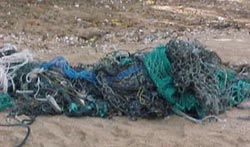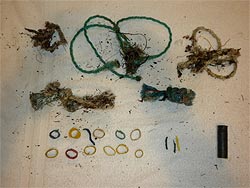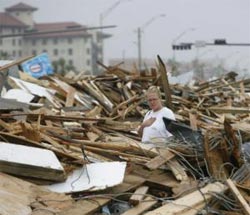Background Information
What are the sources of marine debris?
It has been estimated that container ships lose over 10,000 containers at sea each year. Large amounts come from illegal ocean dumping but the major source world-wide is from rubbish blown to the sea from landfills and runoff from towns and cities through stormwater systems.

Storm water that flows along streets or along the ground as a result of rain or snow can carry street litter into storm drains. Storm drains carry this water and debris to a nearby river, stream, canal, or even directly to the ocean. A typical 3,000-passenger cruise ship produces over eight tons of solid waste weekly. Container vessels caught in rough seas can lose the contents of their containers (for example sneakers, televisions, plastic toys, etc.), or perhaps even the entire container, a steel box 6 – 12 metres long, 2.5 metres wide and almost 3 metres high. Vessels carrying logs or lumber may lose large bundles or individual pieces of wood.
Lost fishing gear and related materials in particular is a major issue. Globally it is estimated that at least 6.4 million tons of commercial fishing gear is lost into the ocean each year.

The Gulf of Carpentaria, at the top end of Australia, provides a stunning example of this. More than 8,000 derelict fishing nets – which add up to 90,000 metres of net – have been cleaned up on beaches in the region.

Offshore oil and gas platforms can also be large contrbutors of marine debris. Typical debris generated from these platforms includes drill pipes and drill pipe protectors, hard hats, gloves, 55-gallon storage drums, and everyday regular litter items.
|
|
The main source differs from country to country. In Australia the main sources of debris are from land, more than half the debris in Australia’s seas comes from this source and up to 80%
around our cities. The next most important source is from fishing, boating (including litter thrown overboard) and shipping industries.

Nets on Australia’s shores come from Australia, Indonesia, Japan, Korea, Taiwan and Thailand (nearly half are of unknown origin).
| Plastics are the largest and most detrimental part of the marine debris problem. The majority of marine debris
is comprised of plastic materials—60-80% overall and 90% of floating debris. |
Extreme natural events such as cyclones and hurricanes, tornadoes, tsunamis, floods and mudslides with their high winds, heavy rains, flooding, and tidal surges are capable of carrying objects as light as a cigarette butt or as heavy as the roof of a two-story house far out to sea.

A single one-litre soda bottle could break down into enough fragments
to put one fragment on every mile of
beach in the entire world. |
Once an item becomes part of marine debris it can take up to hundreds of years to break down.
| Paper Towel 2-4 weeks |
Milk Carton 3 months |
| Cigarette Butts 10 years |
Styrofoam Cup 50 years |
| Glass Bottles 300 years |
Aluminium Can 200-500
years |
|
Next: Where is marine debris found? ...
|

